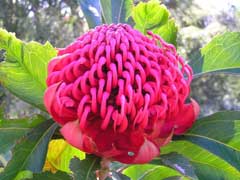 |
|
http://commons.wikimedia.org/wiki/File:Telopea_speciosissima.jpg |
 |
| http://commons.wikimedia.org/wiki/User:Casliber |
Translate this page:
Summary
Physical Characteristics

 Telopea speciosissima is an evergreen Shrub growing to 3 m (9ft) by 2 m (6ft).
Telopea speciosissima is an evergreen Shrub growing to 3 m (9ft) by 2 m (6ft).
See above for USDA hardiness. It is hardy to UK zone 9. It is in leaf all year, in flower in May. The species is hermaphrodite (has both male and female organs).
Suitable for: light (sandy), medium (loamy) and heavy (clay) soils, prefers well-drained soil and can grow in nutritionally poor soil. Suitable pH: mildly acid and neutral soils. It cannot grow in the shade. It prefers moist soil.
UK Hardiness Map
US Hardiness Map
Synonyms
Plant Habitats
Woodland Garden Sunny Edge;
Edible Uses
Edible Parts: Nectar
Edible Uses:
The flowers produce copious amounts of nectar, this can be sipped directly or used to make a sweet beverage[183].
References More on Edible Uses
Medicinal Uses
Plants For A Future can not take any responsibility for any adverse effects from the use of plants. Always seek advice from a professional before using a plant medicinally.
None known
References More on Medicinal Uses
The Bookshop: Edible Plant Books
Our Latest books on Perennial Plants For Food Forests and Permaculture Gardens in paperback or digital formats.

Edible Tropical Plants
Food Forest Plants for Hotter Conditions: 250+ Plants For Tropical Food Forests & Permaculture Gardens.
More

Edible Temperate Plants
Plants for Your Food Forest: 500 Plants for Temperate Food Forests & Permaculture Gardens.
More

More Books
PFAF have eight books available in paperback and digital formats. Browse the shop for more information.
Shop Now
Other Uses
Basketry
The stems are used in basket making[156].
Special Uses
References More on Other Uses
Cultivation details
Prefers a rather poor stony soil[167]. Requires a lime-free soil[182]. Requires a sunny position in a well-drained soil that is low in phosphates[166]. Requires a lot of summer heat, abundant moisture in the growing season and a dry spell when dormant[166]. Only succeeds outdoors in the milder areas of Britain[182], requiring greenhouse protection in most parts of the country[1]. The plant is hardy to at least -7°c in Australian gardens[157], but this cannot be translated directly to British gardens due to our cooler summers and longer colder and wetter winters. Plants have been known to tolerate temperatures down to -5° in Britain, occasionally lower when in a very good position[200]. This plant is the floral emblem of New South Wales[157, 182].
References Carbon Farming Information and Carbon Sequestration Information
Temperature Converter
Type a value in the Celsius field to convert the value to Fahrenheit:
Fahrenheit:
The PFAF Bookshop
Plants For A Future have a number of books available in paperback and digital form. Book titles include Edible Plants, Edible Perennials, Edible Trees,Edible Shrubs, Woodland Gardening, and Temperate Food Forest Plants. Our new book is Food Forest Plants For Hotter Conditions (Tropical and Sub-Tropical).
Shop Now
Plant Propagation
Seed - sow spring in a warm greenhouse. When they are large enough to handle, prick the seedlings out into individual pots and grow them on in the greenhouse for at least their first winter. Plant them out into their permanent positions in late spring or early summer, after the last expected frosts.
Other Names
If available other names are mentioned here
Native Range
AUSTRALASIA: Australia (New South Wales (east-central))
Weed Potential
Right plant wrong place. We are currently updating this section.
Please note that a plant may be invasive in one area but may not in your area so it's worth checking.
Conservation Status
IUCN Red List of Threatened Plants Status :

Growth: S = slow M = medium F = fast. Soil: L = light (sandy) M = medium H = heavy (clay). pH: A = acid N = neutral B = basic (alkaline). Shade: F = full shade S = semi-shade N = no shade. Moisture: D = dry M = Moist We = wet Wa = water.
Now available:
Food Forest Plants for Mediterranean Conditions
350+ Perennial Plants For Mediterranean and Drier Food Forests and Permaculture Gardens.
[Paperback and eBook]
This is the third in Plants For A Future's series of plant guides for food forests tailored to
specific climate zones. Following volumes on temperate and tropical ecosystems, this book focuses
on species suited to Mediterranean conditions—regions with hot, dry summers and cool, wet winters,
often facing the added challenge of climate change.
Read More
Expert comment
Author
(Sm.)R.Br.
Botanical References
200265
Links / References
For a list of references used on this page please go here
Readers comment